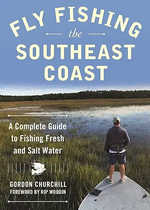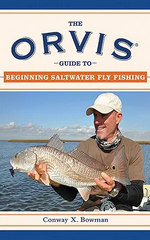Keep those Puppies Comfortable
Getting right to the meat of the problem, having the wrong shoes or boots can ruin your day especially when you are fly fishing.
Mountain Streams & Cold Surf Fishing
Cold water is often associated with fly fishing. It could be a mountain stream any time of the year; or the tailrace below a dam where water is taken from the bottom of the dam so it remains cool enough for trout many miles below the dam; or the surf along the eastern seaboard during the cooler months or the west coast just about any time of year; or it could be any wadable water in our neck of the woods when it is winter time.
During such times and in such locations, you will need protection for your lower extremities- your feet in particular.
Previously we addressed the issue of waders and wading boots. The bottom line is that wading boots face multiple challenges and may have to perform several functions from keeping your feet warm in rough weather to keeping you safe in fast water. Under “Essential Equipment” on the web page for Cape Fear Flyfishers (www.CapeFearff.com), we looked at the two types of waders and made a very strong recommendation -stocking foot instead of boot-foot waders. We suggested you avoid waders with built-in boots and go for those with neoprene “booties” to wear with wading boots purchased separately. Though the more expensive option, you will get a boot that offers far more ankle support and you will be able to switch wading boots to suit the water you are wading. For instance, if the bottom of the creek has mud and small rocks, a good rubber sole will do an excellent job (and some rubber is great wading on slippery rocks and even hiking).
If you are going to be climbing on slippery rocks, felt soles work extremely well. But felt soles are horrid for hiking and because they are thought to transfer invasive species from one stream to another, many states have banned them, insisting upon either rubber soles or rubber with studs or aluminum bars that help grip the rocks through the slime. Of course, this suggests that we are talking about several pairs of wading boots. Or, you could do as I have done and buy a pair of Korkers that come with interchangeable soles that snap into the bottom of the boot. So, you can have more than “one” pair of boots for little more than the cost of one pair. One word of caution: taking the soles on and off can be easier said than done. As far as I know, North Carolina still allows felt soles and other states are beginning to challenge the assertion that the felt is the primary culprit in spreading invasive species. Also, note that if you are using boots with studs or aluminum bars, captains will not be thrilled about having you ride in their boat.
When fishing in cold or cool water, you will need good waders and the right boots .
Below you will find harsh words about the dangers of shoe laces. But, you rightly object, most if not all wading boots has laces of some sort or description. Ah yes, time for creative thinking. Watch this magic: some waders have gravel guards that pull down over the top of the boots to keep gravel from sneaking in and making life really miserable. These gravel guards can extend over most of the laces. For those who have waders without gravel guards built in, you can buy inexpensive stand-alone gravel guards that wrap around the lower leg so it covers the tops of the boot and most of the laces. Problem solved!
Float Fishing
When you float fish, your footwear needs change somewhat. Many of the guides wear sandals but they are young and tough so jumping in and out of 50º F water is no big deal. But those of us who are on the high side of 50 or 60 have enough life experiences to know that such antics are not for us. It would be nice to be a young buck again and wear shorts and a tee shirt when it’s in the 40s. But we are smarter than that.
Getting back to foot wear, since we are “floating” many of us assume we can wear about any shoe we want. But there are some limits to this freedom of choice
First of all, pick shoes/boots with no (that’s NO) shoelaces. No shoelaces? But my boat shoes have shoelaces, my L.L. Bean boots have shoelaces. My sports shoes have shoelaces. What’s the big deal?
The big deal is that when you are floating, you cast out the line and strip it back in. Unless you try to wear a stripping basket while casting and standing up in a drift boat (not an easy task), you will be stripping the line into the bottom of the boat- where your feet are located. The 18th Law of Thermodynamics states that shoelaces and fly lines have an insidious attraction to each other that puts magnetism to shame. If there are shoelaces and fly line within 2’ of each other, they will wrap around each other, usually as you are making a cast to a fish the guide has just seen and suggested that you cast to this monster. Of course, your cast is ruined when the shoelaces keep your cast from going where it was intended to go and the fly lands short, spooking the fish. Or else it waits until the fish has been hooked and starts running. The extra fly line in the bottom of the boat finds your shoelaces just as the fish is running away from you when the fly line stops dead because of its unholy engagement with your shoelaces. The resistance either tears the hook from the fragile mouth of the fish or causes the tippet to snap and break. Game over. You lose. So, NO shoelaces.
Also, floating in a boat does not mean that your feet will stay dry. You have to get in the boat first. Sometimes this means wading in very shallow water to get to where the boat will float with your weight in it.
Further, spray can and will get into the boat. Some boats leak and the water collects on the bottom of the boat. And it can be a lot of water.
Wade Fishing
There are numerous occasions when you will be wading for fish in warm water. You are wade fishing for tropical fish to our south or wading here in the low marsh at very high tide, wading on land that goes underwater only when there are high tides during a New Moon or a Full Moon. The ground under low marsh is usually hard while the land under tall marsh is usually very soft. You want the hard land with low marsh or no marsh grass at all. You can access such marsh by puling your boat (or kayak) into high marsh close to low marsh and going over the side to wade after a fish you have seen that is beyond your casting range. Or you can stake out your kayak and wade in very shallow water toward a fish you have spotted.
The point is, the ground is hard and you can wade silently. In such cases, you want to shuffle your feet slowly instead of taking steps because sting rays like shallow water and you don’t want to step on a sting ray. At best you want to bump into its side as you shuffle along, scaring it off in the process.
If it is warm, you can wear tennis shoes (but no shoelaces sticking out to grab your fly line) and the water temperature is high enough for you not to worry about hypothermia. Or you can wear flats booties that have a thick sole in case you hit a sharp rock or shell and even the wing of a ray.
When it is cooler or cold, remember wool socks will stay warm even when wet or you can get some neoprene booties and shoes large enough for you to wear the thick socks/booties as well as the outer shoe. A number of companies make short boots so you can buy some that are higher that the water you anticipate wading in that day.
A final word. It could be very wise to have an extra pair or two of dry wool socks in the dry bag you carry to keep your car keys, billfold, licenses and other important items from getting lost or wet. A dry bag will float if your boat overturns. It will keep your treasures from getting wet in a pop-up storm. And, if nothing else, it gives you some dry socks to wear from the take-out to go home. There’s nothing worse than wet feet, unless it is losing a nice fish to shoelaces or to carelessly having your foot on top of your fly line and ruining a cast to the fish of a lifetime.
The bottom line is that we need to be concerned about what’s on our feet- separating us from the ground. The footwear we wear should enhance our skill instead of fighting it, helping guarantee our comfort instead of compromising it, keeping us from having one less thing to worry about instead of having our feet call attention to themselves through the pain brought on by poor choices. The old saying suggests we should look before we leap. Perhaps we should start with our feet and work up with our wardrobe choices. There’s nothing that takes the place of happy feet.



